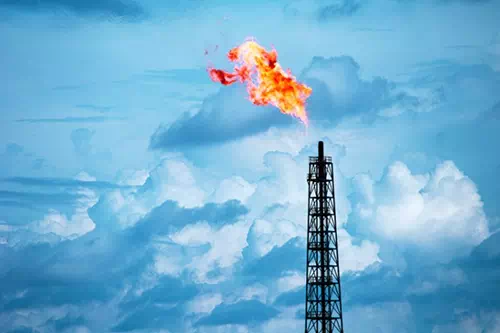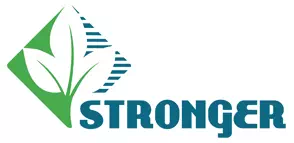|
Processing of Natural Gas at the Wellhead (Field Processing)
Gas wells produce raw natural gas along with other low molecular weight hydrocarbons, known as "natural gas liquids". These include ethane, propane, butane, iso-butane and pentanes. Certain of these hydrocarbons that are that are liquid or semi-liquid at ambient conditions (i.e., pentane and heavier) may be present in the gas; such wells are called condensate wells and the gas is called "wet" gas. Wet gas requires processing to remove condensable hydrocarbons. Once the liquefiable hydrocarbon portion has been removed from the gas stream (in the field or at a separation plant) the gas is called dry gas. Dry natural gas may also be found directly at the gas well. "Wet" and "dry" gas, either, may require dehydration to remove water or sweetening to remove excessive levels of carbon dioxide (CO2) and hydrogen sulfide (H2S). Field processing involves two main processes:
-
Oil and Condensate (light crude oil or liquid hydrocarbons) Removal (separation)
-
Water removal
The need and type of process used to separate any associated oil and condensate from natural gas varies based on composition and physical conditions of the natural gas. The most common type is the "heater-treater," which is a combination of a heater, free-water knockout, and condensate and gas separator. The heater helps to break up the condensate and gas emulsion while the separator operates on simple principal of differentials in density. A significant source of air emissions occur when the condensate is transferred from the heater-treater, which operates under pressure, to an atmospheric storage vessel. These emissions are called "flash emissions" and can dwarf breathing and working losses from a condensate storage tank. In addition to removing any condensate from the natural gas, it is also necessary to remove most of the associated water. Most water associated with extracted natural gas is removed by simple separation methods. However, the removal of the water vapor that exists in solution in natural gas requires a more complex treatment. Three main approaches toward dehydration are the use of a liquid or solid desiccant, and refrigeration. Of these three approaches, glycol dehydration is the most common when processing occurs in the field (i.e., at or near the well). With glycol dehydration, a liquid desiccant dehydrator serves to absorb water vapor from the gas stream. The water can be evaporated from the glycol by a process called heat regeneration, and the glycol can then be reused after being put through a specialized boiler designed to vaporize only the water out of the solution.
Potentially Applicable Regulations
Clean Air Act (CAA)
-
Condensate Storage
- 40 CFR Part 60 Subpart A. General provisions, including control device and work practice requirements for flares and compliance with standards and maintenance requirements (maintain air pollution control equipment in a manner consistent with good air pollution control practice for minimizing emissions).
- 40 CFR Part 63 Subpart A. General provisions, General provisions and compliance with standards and maintenance requirements (maintain air pollution control equipment in a manner consistent with good air pollution control practice for minimizing emissions).
- 40 CFR 60 Subpart K, Ka or Kb. Standards of Performance for Volatile Organic Liquid Storage Vessels
- 40 CFR Part 60 Subpart OOOO and Subpart OOOOa. Standards for Performance for Crude Oil and Natural Gas.
- 40 CFR 63 Subpart HH. National Emission Standards for Hazardous Air Pollutants from Oil and Natural Gas Production Facilities.
- 40 CFR 98 Subpart W. Petroleum and Natural Gas Greenhouse Gas (GHG) Reporting Rule.
-
Dehydration at Well Site
- 40 CFR Part 63 Subpart A. General provisions, General provisions and compliance with standards and maintenance requirements (maintain air pollution control equipment in a manner consistent with good air pollution control practice for minimizing emissions).
- 40 CFR 63 Subpart HH. National Emission Standards for Hazardous Air Pollutants from Oil and Natural Gas Production Facilities.
-
Gathering Lines
- 40 CFR Part 60 Subpart A. General provisions, including control device and work practice requirements for flares and compliance with standards and maintenance requirements (maintain air pollution control equipment in a manner consistent with good air pollution control practice for minimizing emissions).
- 40 CFR Part 63 Subpart A. General provisions, General provisions and compliance with standards and maintenance requirements (maintain air pollution control equipment in a manner consistent with good air pollution control practice for minimizing emissions).
- 40 CFR Part 60 Subpart OOOO and Subpart OOOOa. Standards for Performance for Crude Oil and Natural Gas 40 CFR 63 Subpart HH. National Emission Standards for Hazardous Air Pollutants from Oil and Natural Gas Production Facilities.
- 40 CFR 60 Subpart JJJJ. Standards of Performance for Stationary Spark. Ignition Internal Combustion Engines.
- 40 CFR 60 Subpart GG. Standards of Performance for Stationary Gas Turbines.
- 40 CFR 60 Subpart KKKK. Standards of Performance for Stationary Combustion Turbines.
- 40 CFR 63 Subpart ZZZZ. National Emission Standards for Hazardous Air Pollutants for. Stationary Reciprocating Internal Combustion Engines (RICE).
- 40 CFR 98 Subpart W. Petroleum and Natural Gas Greenhouse Gas (GHG) Reporting Rule.
CERCLA. Reporting of spills if above reportable quantity for waste oils (e.g., F010, K042 through K048).
Clean Water Act (CWA)
- Wastewater Point Source Discharges (Section 402). Where direct discharge of wastewater (e.g., flowback, produced water) is permitted, the owner/operator must obtain a National Pollutant Discharge Elimination System (NPDES) permit. NPDES permits are issued by EPA or authorized states.
- Wastewater Indirectly Discharged via Publicly Owned Treatment Works (POTW) (40 CFR 302). EPA has established pretreatment standards that apply to wastewater (e.g., flowback, produced water) discharged to POTWs by industry.
- General prohibition of discharges of wastewater pollutants from onshore unconventional oil and gas operations to POTWs. (40 CFR 435) The standards prohibit discharges of wastewater pollutants from onshore unconventional oil and gas (UOG) extraction facilities to publicly owned treatment works (POTWs).
- Wastewater Indirectly Discharged via Centralized Waste Treatment (CWT) (40 CFR 302). When wastewater (e.g., flowback, produced water) is transported to a CWT, it is the responsibility of the CWT to properly treat and discharge it.
- Stormwater (Section 402, 40 CFR 122). Stormwater is generated when precipitation from rain and snowmelt events flows over land or impervious surfaces and does not percolate into the ground.
- Spill Prevention, Control and Countermeasures (SPCC) (Section 311, 40 CFR 112). Includes requirements for oil spill prevention, preparedness, and response to prevent oil discharges to navigable waters. Examples of oil at drilling, production include:
-
Flowback water containing oil.
-
Fuel for drill rig.
-
Oily waste.
-
Some Hydraulic Fracturing fluids (e.g., friction reducers are frequently petroleum based).
-
Hydraulic oils (e.g., for use with pump jacks).
-
Produced water container or pit containing oil (i.e., a produced water container or pit means a structure at a well that is used to store the produced water after initial oil/water separation, and prior to reinjection, beneficial reuse, discharge, or transfer for disposal).
- Oil separated in condensate tanks - Frequently, natural gas is "wet," that is it could also contain water and varying amounts of other volatiles and oil.
-
Oil present in gathering lines - Gathering lines may fall under SPCC if the owner/operator creates a unique facility boundary. For example, a company could decide to have 17 batteries in a distinct geographic area be considered one facility. This decision would have placed the gathering pipes connecting these 17 batteries boundary under SPCC coverage unless the pipes are already regulated under Department of Transportation 49 CFR Parts 192 or 195.
Emergency Planning and Community Right-to-Know Act (EPCRA) (Sections 302, 303, 311, and 312). EPCRA requires facilities that use or store hazardous chemicals in certain quantities to report those inventories to state and local emergency planning organizations. Resource Conservation and Recovery Act (RCRA) Subtitle C (hazardous waste) and Subtitle D (solid waste). RCRA is the primary law for regulating solid and hazardous wastes. Safe Water Drinking Act (SWDA). Administered under the SDWA is EPA's Underground Injection Control (UIC) program, which is responsible for regulating the construction, operation, permitting, and closure of injection wells that place fluids underground for storage or disposal. Available emergency response authorities to address adverse impacts:
-
Safe Water Drinking Act (SDWA) (Section 1431). Action to address imminent and substantial endangerment caused by contaminants present or likely to enter a public water system or underground source of drinking water.
-
Clean Air Act (CAA) (Section 303). Action to address imminent and substantial endangerment of public health or welfare, or the environment from air emissions or pollution.
- Comprehensive Environmental Response, Compensation, and Liability Act of 1980 (CERCLA) (Section 104) Removal action to address release that may present imminent and substantial endangerment, subject to the "petroleum exclusion."
- Comprehensive Environmental Response, Compensation, and Liability Act of 1980 (CERCLA) (Section 106). Order to address imminent & substantial endangerment, subject to the "petroleum exclusion."
- Clean Water Act (CWA) (Section 504). Action to address imminent & substantial endangerment to health, welfare, or livelihood caused by discharge from "pollution source."
-
CWA/OPA 311 action to address imminent and substantial threat to public health or welfare from discharges of oil or hazardous substances to navigable waters.
- Resource Conservation and Recovery Act (RCRA) (Section 7003). Action to address solid waste handling that may present an imminent & substantial endangerment to health or the environment.
More Resources
NaturalGas.org - Processing Natural Gas. An educational website maintained by the Natural Gas Supply Association that covers a variety of topics related to the natural gas industry. The purpose of this website is to provide visitors with a comprehensive information source for topics related to natural gas, and present an unbiased learning tool for students, teachers, industry, media, and government.
|






